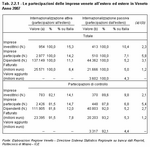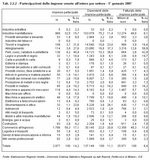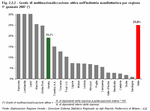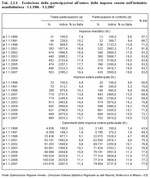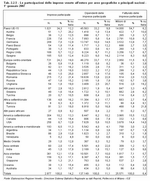2.2 Veneto's mobile businesses
|
In his handbook on International Economics, Professor Dominick Salvatore defines a "mobile enterprise" (Note 1) as an industry that tends to relocate to where availability of input leads to minimum production costs. On the basis of this idea, we analysed Veneto's 954 MNEs, i.e. the enterprises based in Veneto that had an interest in at least one foreign business in 2007 (Note 2). Veneto's MNEs have an interest in 2,977 foreign businesses; they employ 137,149 people abroad and in 2006 had a business volume of 25,571 million euro. Veneto's MNEs have a controlling interest in 81.5% of their foreign-invested companies, which account for 78.7% of employees abroad and 84% of turnover. As regards the overall share of Italian investments abroad, Veneto holds 14.1% of Italian multinationals, 14.2% of foreign-invested enterprises, 11.1% of employees and 6.4% of turnover. Regarding controlling interests, Veneto accounts for 14.1% of the national total of investors, 14.7% of the foreign-invested companies, 12% of employees and 7.8% of turnover. (Table 2.2.1).
Concerning foreign-invested companies in Veneto, at the start of 2007, foreign MNEs had an interest in 510 of the Veneto businesses operating in the sectors of the Reprint database; these businesses employed 44,362 people and had an aggregate turnover of 21,666 million euro in 2006 (Note 3). Their controlling interests, mainly equal or minority, concerned 87.8% of the foreign-invested companies in Veneto; these companies also accounted for 92% of employees and 93.2% of turnover. These figures seem to be in line with those on a national level, where the share of controlling interests amounts to 92.1% of the foreign-invested enterprises, 91.1% of employees and 89% of turnover. Veneto accounts for 7.1% of Italy's foreign-invested companies, 5.2% of their employees and 5% of their turnover. The percentage of Veneto businesses in which MNEs have an interest suggests that Veneto plays a lesser role in this area at a national level than it does in other areas of the economy. To conclude, it appears that Veneto has a much higher rate of investment abroad than foreign companies investing in Veneto. The number of Veneto's foreign-invested companies abroad is almost six times higher than the number of foreign-invested companies in Veneto, and the employee ratio is more than three to one. Regarding turnover, however, the gap between Veneto's foreign-invested companies abroad and foreign-invested companies in Veneto is much lower due to Veneto's major interest in foreign investment for production purposes (given the relative cost of capital and labour) and its focus on labour-based technologies.
More than 90% of Veneto's foreign-invested companies abroad are involved in two sectors: manufacturing and wholesale trade. Manufacturing leads the way in terms of the number of foreign-invested companies, accounting for just under one third of the total; however this one third employs more than three quarters of the total number of workers abroad and is responsible for almost half of turnover. Veneto has an interest in 968 businesses abroad employing more than 103,000 people with a turnover of more than 12.2 billion euro in 2006. More than half of Veneto's foreign-invested companies abroad deal with trade and after-sales assistance. Figures report 1,766 businesses, mainly outlets for manufacturing firms, with more than 30,000 employees and a turnover of more than 12.3 billion euro, just above the turnover of manufacturing businesses. Overall, however, the multinational activities of Veneto businesses are marginal in other areas, and in the tertiary sector in particular.
Currently available figures provide a further insight into manufacturing activities, Veneto's most important sector. Since 2000, there has been little change in the share of foreign-invested manufacturing companies in terms of their technology level; manufacturing is still very much dominated by low-tech activities and accounts for nearly 58% of the employees in Veneto's foreign-invested companies abroad; then come medium-low tech activities with 20%. At the other end of the scale are Veneto's high-tech activities, which account for 6% of the total. (Figure 2.2.1). When compared with the national average, Veneto's foreign-invested companies abroad seem to specialise in low-tech sectors, particularly in the traditional Italian industries of textiles and clothing and leather and footwear, which employ more than 37,000 people in about 350 foreign-invested companies. An important, though lesser, role is also played by other manufacturing industries (44 foreign-invested companies with more than 2,500 employees), which include another two of Veneto's specialised areas: furniture and goldsmithery (Note 4) (Table 2.2.2). It is also worth noting the share of Veneto foreign-invested companies abroad that deal with metalworking and electrical, electronic and optical products. Veneto accounts for 37.3% of Italy's employees abroad in the clothing industry; 36.8% in the leather and footwear industry; 26.1% in instrumentation and optics; 23% in textiles and knitwear; and 19.6% in electric machinery and equipment. Veneto also stands out for the growth rate of its employees abroad between 2001 and 2007 in the following sectors: textiles and knitwear (+50.5%); clothing (+47.4%); mechanical machinery and equipment (+39.6%); electric machinery and equipment (+32.8%); and instrumentation and optics (+19.3%). Special mention should also go to the sharp increase in wholesale-trade employees (+47.9%), which indicates a major strengthening in the commercial networks of many manufacturing businesses.
A more accurate assessment of Veneto's active multinationalisation is afforded by comparing its figures with those nationwide. To achieve this, the number of foreign-invested companies abroad can be compared with the size of a sector's economy. One indicator of an economy's level of active multinationalisation can be garnered by comparing the number of employees in foreign-invested companies abroad with the number of employees in non foreign-invested companies based at home. (Note 5).
As regards active multinationalisation, Veneto has a 15.8% share of employees abroad out of the total employees in non foreign-invested companies based in Veneto, a figure that is just below the national average (16.7%) (Note 6). A glance at the individual sectors reveals that Veneto's level of active multinationalisation is only higher than the national average in wholesale trade (40.7% against 21.9%). Apart from the manufacturing industry, which has a level of active multinationalisation verging on the national average (19.2% against 25%), Veneto performed extremely modestly in the remaining sectors in terms of internationalisation and its figures are significantly lower than the national average. Likewise, foreign direct investment in Veneto is only in line with national figures in the mining industry, while the remaining sectors fall well below that level. Overall, both Veneto's active and passive multinationalisation are below the national average. (Table 2.2.3). A comparison of Veneto's multinationalisation performance with that of Italy's other regions reveals that Veneto's active multinationalisation is second only to Lombardia in terms of the number of investing businesses and the number of foreign-invested companies abroad. However Veneto fell to third place, overtaken by Piemonte, in terms of the number of employees abroad and to fourth place, overtaken by Lazio, in terms of turnover. Veneto ranks fifth among Italy's regions for passive multinationalisation in terms of the number of its local foreign-invested companies and number of employees behind Lombardia (which alone accounts for about half of the national total), Piemonte, Lazio and Emilia Romagna. (Figure 2.2.2). The highest levels of active multinationalisation are to be found in Piemonte and Lombardia, the two regions containing Italy's largest and most internationalised businesses. Veneto's manufacturing industry lies just below the national average behind Marche and Emilia Romagna. It is likely that Veneto's multinationalisation performance, though positive, is partly governed by the opportunities for relocation offered to local businesses by the extensive network of Veneto entrepreneurs who have launched businesses in Eastern Europe, as these businesses are a valid alternative to Foreign Direct Investment. However the region's performance is also down to the domination of its economic structure by medium-low tech companies, which are innately less inclined towards internationalisation via direct investments.
We have already mentioned that from early 2001 to early 2007 trends for Veneto's foreign-invested companies abroad developed more quickly than for Italy as a whole. The following figures provide an insight into this phenomenon. In the period considered, the number of Veneto's foreign-invested companies abroad grew by 35.1% against 25.8% at national level. There was an even sharper increase in the number of employees abroad and in turnover by foreign-invested companies, which shot up by 65.1%, against 41% nationwide. If we look only at manufacturing, the number of persons employed by foreign firms with Veneto investments has grown by 35.4%, while on a national level growth has been 2.9%. During this period, the number of Veneto's foreign-invested companies abroad also rose in all the macro-sectors being studied, with growth ranging from 15.4% in professional services to 65% in the mining industry. These levels are also due to extremely modest starting levels.
Long-term analysis of the manufacturing industry shows that in the mid-1980s multinational production by Veneto's businesses was very low; there were only 21 foreign investors who had an interest in 33 foreign manufacturing businesses with less than 5,000 employees. From then on the situation developed non-stop until 2007 and although the growth rate slowed it was still consistently higher than growth nationwide. In a period that spans over 20 years (1.1.1986-1.1.2007), the number of Veneto's MNEs with manufacturing activities abroad rose 24-fold, reaching more than 500 units. The number of foreign-invested companies abroad rose almost 30-fold, skimming the thousand-mark, while the number of employees abroad multiplied 20-fold, to more than 103,000. This trend of the various variables is even more sustained when considering controlling interests alone. (Table 2.2.4). Geographical orientation
As concerns the geographic trends of Veneto enterprises with foreign direct investments, almost two thirds of enterprises and 70% of their employees are located in Europe. Veneto businesses also have 1,021 foreign-invested companies abroad and about 45,500 employees in other EU15 companies; 721 of Veneto's foreign-invested companies abroad and 46,3000 employees are located in Central and Eastern Europe, while another 87 companies vaunting just over 2,600 employees are located in other countries across Europe. Asia, North America, Latin America, Africa and Oceania follow as other areas of investment. (Table 2.2.5). Compared with the national average, Veneto firms seem more inclined to invest in countries in Central and Eastern Europe, North Africa and Central Asia. The direct presence of Veneto businesses in the Americas, Middle East and Oceania is still fairly modest in national terms. The correlation between sectoral specialisation and the choice of area highlights that a reduction in labour costs is a major determinant when Veneto businesses invest abroad. |
|
Data processed by the Statistics Office of Regione Veneto are collective property; reproduction of this material is authorised for non-commercial purposes only, provided the source "Regione Veneto - Regional Statistics System Management" is acknowledged.
English translation by the University of Padova Language Centre.




